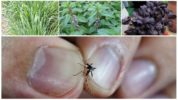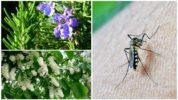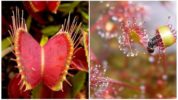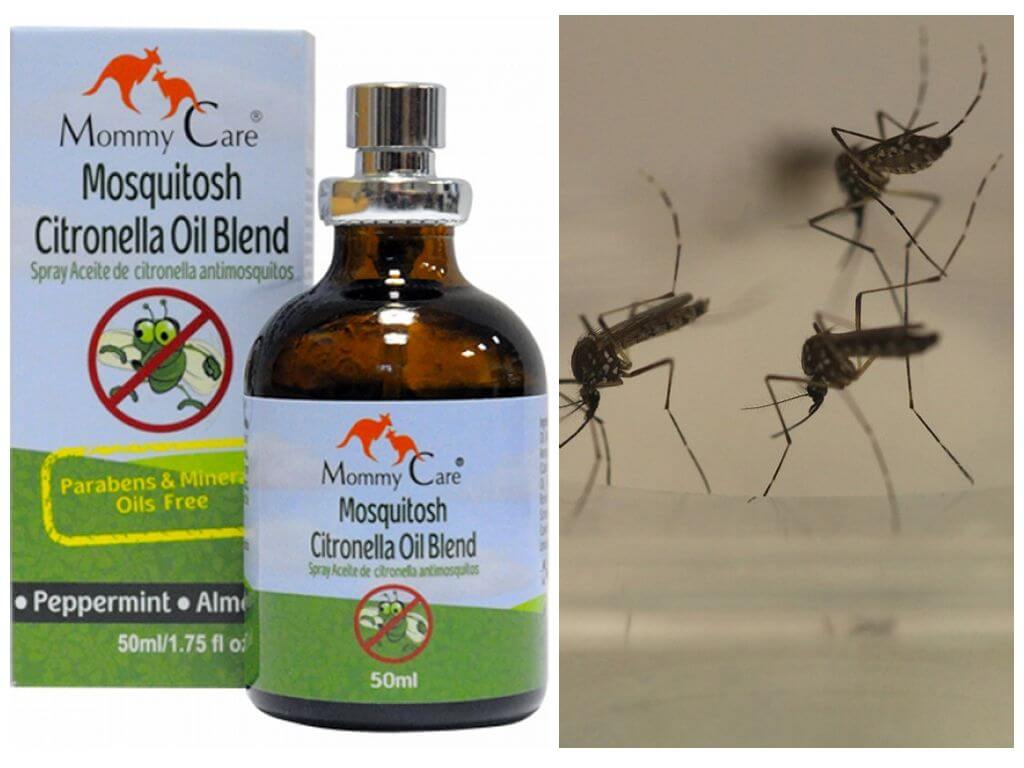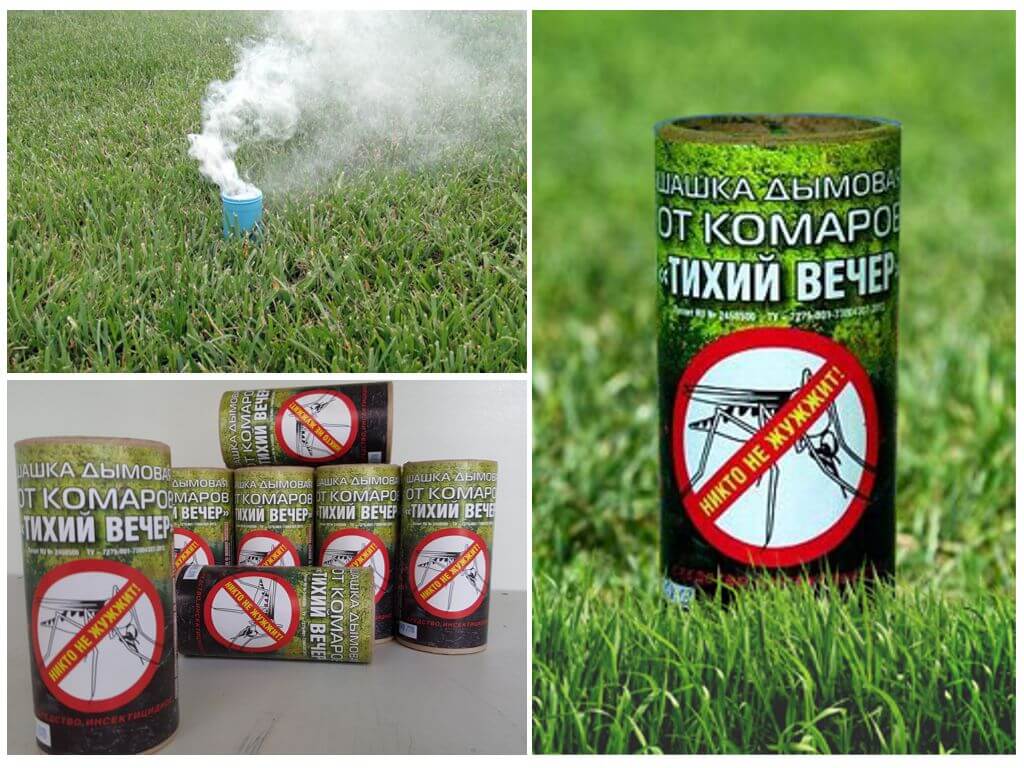- Mosquito grass
- Flowers from mosquitoes
- Insect repellent shrubs
- Predatory plant against mosquitoes
In the summer, even in front of city dwellers, the problem of a mosquito invasion rises to the full. In the dachas and in private homes from these bloodsuckers there is absolutely no salvation if there is at least a barrel of rainwater nearby. A water tank should be near each private house and cottage according to the requirements of fire safety. Can fight mosquitoes via mosquito nets, industrial insecticides or using aroma oils. But there is another option that does not change the living conditions, but requires some knowledge in botany. These are insect repellent plants.
Live repellents
Repellent - a substance that repels insects. It cannot be alive. A plant is a multicellular living organism and cannot be a repellent. The plant emits repellents. In colloquial speech, for brevity, all the intermediate links are thrown away and instead of “plant that produces repellent”, only “plant-repellent” remains.
Those plants that can produce essential aromatic oils scare away insects. Almost all ordinary fresh table spices are repellents. Mosquitoes are afraid not just spices. Different plant forms can scare away bloodsuckers:
- herbs;
- flowers
- Shrubs
- trees.
Herbs are most common as repellents, as they often bring double benefits: in the fresh state they repel insects, and in the dry state they can be used as seasoning. There are few repellent trees and not every one of them can be planted near the house.
To protect against mosquitoes, flowers, herbs or shrubs are planted under the windows in the house. Some of the flowers are not very large and can grow in pots, can be put on the windowsill.
Important!
Planting trees near the house is undesirable, as their root system breaks the foundation.
Planting trees around the perimeter of the garden will help to cut off part of the aggressors on approach. The rest will break through to the second line of defense - spicy herbs in the beds. The final frontier is flowers planted under a window or grown on a windowsill.
On beds it is best to grow useful herbs, flowers under the window and on the window. Shrubs are placed taking into account the topography and landscape of the site.
On a note!
Be sure to take into account the flowering time of plants, so that they gradually succeed each other and protect against mosquitoes the whole warm season.
Mosquito grass
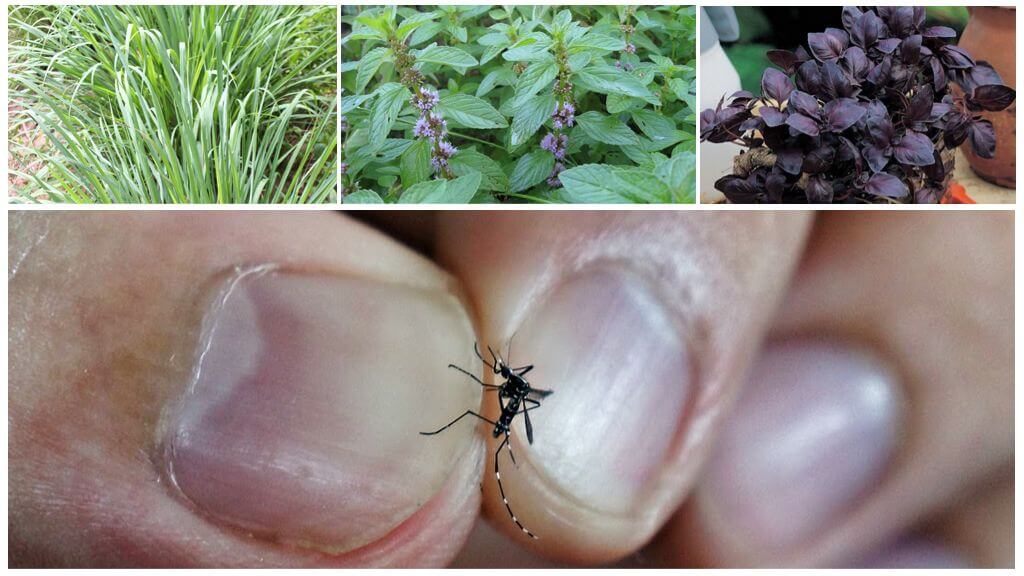
These are the herbs that are often grown by summer residents who want to provide themselves with spices or delicious tea for the winter. Some plants are frank European weeds to watch out for.
- Peppermint. Cultivated plant, a hybrid of water and ears of mint. Blooms almost all summer: July-September. The plant is perennial, withstands cold well. Peppermint needs an alternation of light and shadow.
- Pennyroyal. It is found in the wild in the Crimea and the North Caucasus. The smell is very strong. For this reason, the plant is not suitable for planting under windows. Well suited for landing around the perimeter of the site. A scattered scent will not annoy the residents of the house, but will scare away mosquitoes. Mint is a marsh hydrophilic plant. Grows to 60 cm.Flowering in July-August.
- Basil. The species used in cooking refers to annual plants. You can plant not only between the beds, but also under the window. It grows well in pots on the windowsill.
- Cat mint. A nondescript weed that prefers wastelands, roadsides, slopes, and edges. It grows to a height of 1 m. It has a pleasant lemon smell that repels mosquitoes and other insects. The name received due to the addiction to it of representatives of the cat family. The action is similar to that of valerian due to the essential oil of non-detalactone. Hallucinogenic effects of catnip on people were noted. Therefore, when planting a plant in order to protect against mosquitoes, you need to be careful.
- Melissa. Better known as lemon mint. European weed growing on the edges and ravines in clay and loamy soils. Of the cultivated medicinal varieties, the most common are Quedlinburg creeping and Erfurt erect. Dies in waterlogged places. It withstands shade, but the aroma becomes weaker. It blooms in June and August.
- Citronella The real name is Zimbopogon. Under the name citronella, two species are hiding at once: Cymbopogon winterianus and Cymbopogon nardus. Perennial southern grass with a strong lemon smell. In the northern latitudes it becomes annual. If you need to save the plant, it is planted in large pots and cleaned for winter. In natural conditions it grows up to 2 m. It is very popular. mosquito repellent citronella oil, which is part of many industrial mosquito repellents and often appears in folk recipes.
- Tansy is ordinary. Perennial weed plant. Distributed everywhere. It grows to 150 cm. You can distinguish it from other similar herbs by the characteristic smell of camphor. Flowering in July-September.
- Garlic. Ordinary garden culture. Helps mosquitoes with regular use inside. A one-time promotion is useless. Garlic growing in the garden is also able to deter mosquitoes. But to plant it directly under the windows is a matter of taste.
- Thyme. The second name is Thyme. Common thyme is grown as a seasoning in the southern regions. Height is up to 40 cm. Flowering is June-July. The strong smell of flowering thyme drowns out the smell of carbon dioxide emitted by a living organism, which attracts mosquitoes.
Flowers
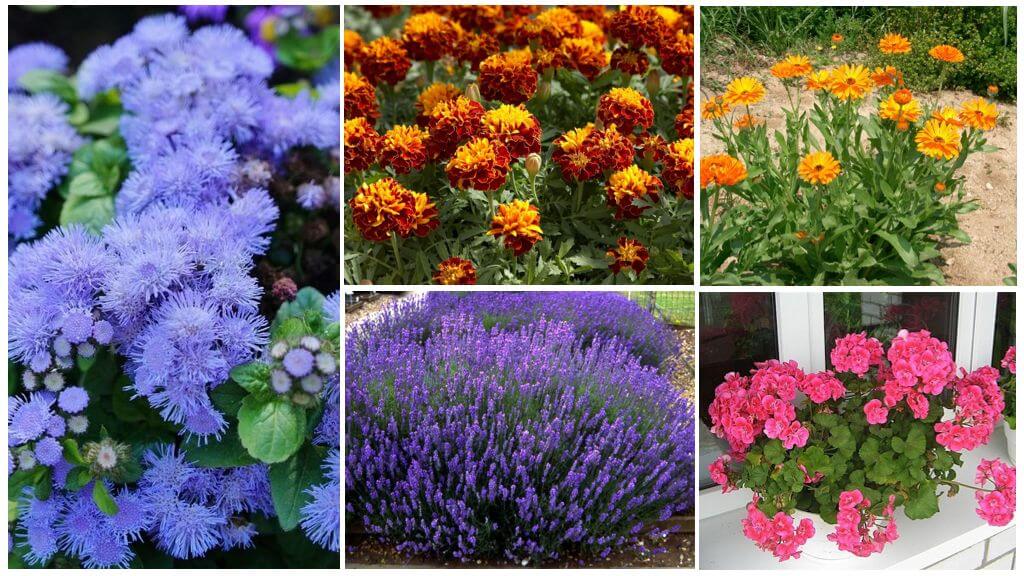
In Russia, repellent flowers can be divided into two categories: indoor and garden. And in parallel to perennial and annual. Perennial flowers are those that are shrubs in their homeland. In adverse conditions, they remain grassy, and some die from frost.
Interesting!
The choice of flowers, especially indoor ones, is not great. In fact, geranium was hardly just an attribute in pre-revolutionary bourgeois houses. With a high degree of probability, she performed the role of modern repellents.
Mosquitoes can be scared away:
- Narrow-leaved lavender - flowers with sensations “dry” in sensation up to 60 cm high. As an exception, they grow up to 1 m. In the southern regions, lavender is an evergreen plant, but freezes from frost in the latitude of Moscow and to the north. It has a strong aroma that repels mosquitoes.
- Marigold. Perennial or annual plants up to 120 cm high form a sprawling or compact bush. In the gardens, small-flowered Tagetes patula L. are bred. They bloom from June until the frost. The smell is specific and may seem unpleasant.
- Geranium. About 40 species of geraniums grow on the territory of Russia. In any climatic zone, it is easy to choose the suitable view for landing in open ground. Plant height varies depending on living conditions. Cultivated fragrant geranium is best suited for breeding on a windowsill to protect against mosquitoes.
- Calendula. An annual plant from the same Astrov family as marigolds. The height of the stems is up to 75 cm. Flowering from June until the first frosts. Propagated by seeds. Loves lighted places. Relatively cold resistant (up to -5 ° С).Calendula tincture is often used to treating mosquito bites.
- Ageratum. A flower from the Astrov family up to 50 cm high. Perennial. Flowering from June to frost. Photophilous and drought tolerant. In the gardening cultivated Ageratum Gaustona / Mexican. In Russia, grown as an annual. It is unstable to cold weather. Long-term cultivation is possible in greenhouse or room conditions.
Shrubs

The selection of repellent shrubs in Russia is small. One of them is southern rosemary, which becomes annual when planted in open ground in the northern regions, the second is bird cherry:
- Rosemary. Evergreen shrub from the Mediterranean belt. In the northern regions, it is grown as an annual grass. The smell of rosemary resembles a complex mixture of lemon, pine, eucalyptus and camphor.
- Bird cherry. In fact, most often it is a low tree, but it can also be a shrub. The height of the bird cherry is up to 10 m. The height of the bush begins from 60 cm. The bird cherry blossoms early, in May-June.
Trees
Some trees can also save from mosquitoes:
- Walnut;
- catalpa begoniform;
- catambra.
The last two actually belong to the same species of Catalpa begoniform. Catambra is just a variety. But this variety contains 4 times more catalpole - a deterrent.
On a note!
Trees are most often not compatible with any other plants. Catalpa is planted along the roads as an ornamental plant. This is a southern tree that is not suitable for the northern regions.
The same situation with walnuts. Its place of growth is the southern regions of Russia. Only wild barley and dogwood grow well under a nut.
Predatory plants
They grow on soils poor in nutrients. To make up for trace elements lacking in the soil, they adapted to eat insects, including mosquitoes. Use active (retention of the victim by a hunting organ) and passive (self-sticking) hunting methods.
Most "predators" come from cold regions and can easily tolerate frost in the open ground. But they are demanding on soil, water and usually hygrophilous. Exception: Tuberous sundews and Lusitanian Rosolist.

At home, novice lovers grow an ordinary Rosyanka and a Venus flytrap. Rosyanka is widespread in Russia, the birthplace of the Venus flytrap - swamps of the eastern part of the USA.
Venus flytrap collapses two halves of a leaf. Dewdrop wraps a leaf around the victim.
Plants are of little use as protection against mosquitoes. Their metabolism is slow. They digest one insect for several days. With an excess of animal food, the "predators" do not have time to assimilate everything completely. Organics decay, the plant becomes sick and dies. Very susceptible to fungal disease and pests (aphids).
Important!
Predatory plants do not scare away, but attract insects.
How to enhance the smell of plants
Honest answer: no way. Essential oils evaporate when exposed to sunlight, and repellent plants smell stronger in hot, dry weather. This is especially true of thermophilic lavender and thyme. To enhance the smell of plants on a cloudy day, it is enough "just" to provide them with dry air and the required amount of solar radiation. People have not yet learned to manage such phenomena.
The second option: wait until the necessary plants are artificially genetically modified in the laboratory.
Compatibility
When planting repellent plants, their compatibility with other crops must be taken into account. “Who is friends with whom” can be seen in the table below.
| Peppermint | Cabbage and tomatoes |
|---|---|
| Basil | Tomatoes and Peppers |
| Thyme (thyme) | Cabbage |
| Garlic | Legumes, onions, potatoes, strawberries and tomatoes |
| Marigold | Potatoes, strawberries and tomatoes, roses and gladiolus |
| Calendula | Wild strawberries and tomatoes |
| Rosemary | Cabbage, Onions, Beans |
Conclusion
When choosing living plants as a way mosquito protection in the country, a personal plot, it is best to plant bird cherry under the windows, combining it with flowers. Bird cherry will protect during the first breeding of mosquitoes in early summer, and aster flowers during the remaining summer. With this choice, the plants will not interfere with each other. Bird cherry can also be planted as a hedge around the perimeter of the site. Grasses are best planted in garden beds so that they scare away not only mosquitoes, but also other pests.
